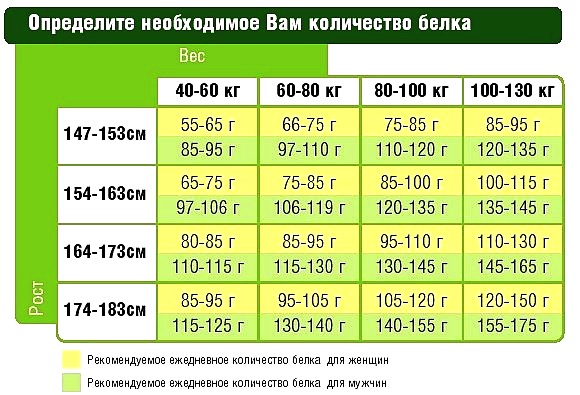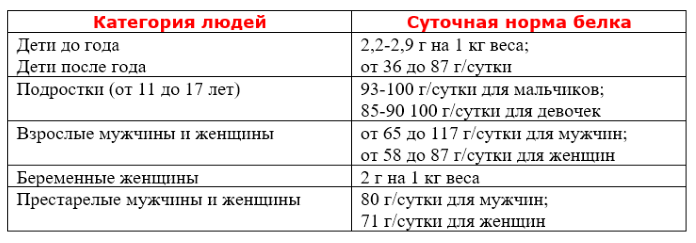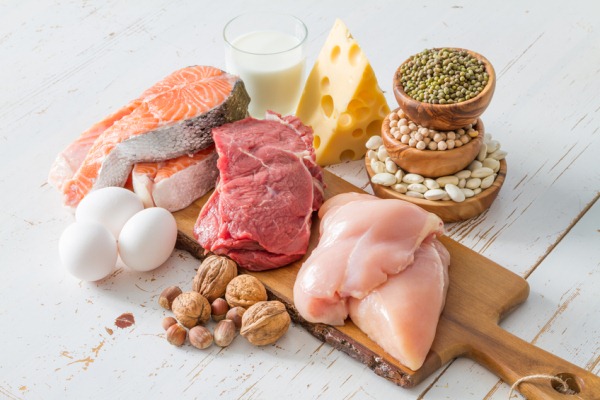The daily protein intake recommended for women and men of different ages is necessary for the body to maintain the normal functioning of all body systems. Depending on whether a person wants to transform his body, as well as what lifestyle is habitual for him, the volume protein food should vary.
Knowing the signs of a deficiency of nutrients will help prevent the development of serious diseases by adjusting the diet in time.
The role of protein in the body
The daily protein intake for women is determined by the physiological characteristics of their body. Of the 20 amino acids that make up the useful substance of the type under consideration, 9 are officially recognized as “irreplaceable”.

They received such a characteristic due to the inability of the female body to produce them independently. The only way to get them is to eat enough protein daily.
Following the recommendations for the daily amount of protein consumed, a woman:
- avoid the destruction of muscle fibers (especially important for those who regularly exercise in the gym);
- normalizes her appetite (with a lack of protein, the body mistakenly sends a signal to the brain center about the need for an additional source of energy, which is felt by the woman herself as an acute feeling of hunger);
- stabilizes the energy levels of the body;
- prevent the slowdown of metabolic processes (a low metabolic rate leads to the formation of fatty deposits, which can only be eliminated when a balance is achieved between proper nutrition and a sufficient level of physical activity);
- will be able to keep his figure in shape (the body spends 20 - 35% of the energy it receives for the assimilation of protein food, which allows it to allow only "useful" calories in a limited amount into the body);
- strengthens its immune system (the protein contains the glutathione tripeptide, which has a beneficial effect on human immunity).
Despite the large number of positive consequences of taking the proper amount of protein, it is undesirable to exceed the recommended rate on an ongoing basis. This can cause dehydration of the body, requiring a large volume of fluid intake every day, which forces the kidneys and bladder to work at their limit.
Calculation of the daily protein intake
To make it easier to calculate the daily protein intake for a person, professional nutritionists and experts in sports nutrition have derived an average indicator that can be applied to women under the age of 35 who do not have health problems and lead an active lifestyle (active work or gym not less often 3 times a week).
The daily protein intake for such people ranges from 1.5 to 2.5 g of protein per 1 kg of actual weight. If the lifestyle of a particular person does not imply active physical activity, it will be enough for him to consume protein in the amount of 1 g of protein per 1 kg of the woman's actual weight.
If a girl wants to lose weight or, conversely, gain muscle mass, the amount of protein foods should be calculated individually. For the convenience of conducting calculations during the day, it is recommended to use programs on smartphones. They allow you to record the amount of nutrients received per day, the introduction of the name of the product and its weight into the appropriate fields.
Taking into account the high energy consumption of the body for the assimilation of protein foods, the calculations of the required daily amount of protein consumed should be especially taken into account by people with diseases of the kidneys and genitourinary system. Their norm, under standard circumstances, is considered to be 0.5 - 0.9 g of protein per 1 kg of actual body weight.
In order for the protein food supplied to the body to be absorbed as easily and correctly as possible, 1/3 of its total volume should be proteins of exclusively plant origin.
In plant food, there are practically no fats that can additionally load internal organs and systems, forcing them to work "at the limit".
Recommended amount of protein per day based on fitness and goals
The daily protein norm for women is calculated not only taking into account the actual physical form of a particular person, but also the goals that he wants to achieve in transforming his own body, as well as the characteristics of his current state of health (age characteristics, pregnancy, menopause, lactation period, and so on) ...
| Determining Factors Affecting Calculation of Protein Amount | Recommendations from nutritionists and sports nutrition experts |
| According to age | With age, the female body undergoes a number of physiological changes that affect the rate of metabolic processes, as well as the loss of a number of functions of specific organs or systems. As the body ages, its need for a large amount of protein food decreases significantly. This is due to the end of the growth of the body and the formation of internal organs. When calculating the required amount of protein, it is also important to note the low rate of the process of its assimilation by the representatives of the fair half of humanity. Considering that most of the nutrient is not absorbed by the female body, it is recommended to add 5-10% to the standard norms given for women after 30 years. The most controversial issue is the need to consume large amounts of protein in older women (after 50 years). Modern research proves that protein deficiency in them entails a deterioration in the functioning of the cardiovascular system, exacerbation of existing diseases, as well as a breakdown and disruption of the central nervous system. In order to supply your body with a sufficient amount of nutrients in old age, it is enough to consume 70-75 g of protein per day, while controlling that the share of animal protein is no more than 43 g. Based on the data of the Institute of Nutrition, women between the ages of 20 and 40 are advised to rely on average values (up to 2.5 g per 1 kg of actual body weight + 5-10% in agreement with a therapist who has an idea of \ u200b \ u200bthe required daily amount of protein food to calculate the required daily volume of protein food) on the health status of a particular person), and after 40 and 50 - the optimal solution would be to reduce protein intake, to the minimum values - no more than 75 g per day. |
| For muscle building | For a qualitative increase in muscle mass, it is necessary, first of all, to adjust your diet by determining the daily minimum amount of essential nutrients, including proteins. To do this, you can use online calculators, indicating the result that a woman wants to get as a result of transforming her own body. If you want to make calculations "manually", it is recommended:
To determine the daily calorie intake, the Mifflin-San Geor formula is most often used: (10 * ... (actual weight of a woman in kg) + 6.25 * ... (actual height of a woman in cm) - 5 * ... (number of full years) - 161) * A (coefficient of physical activity during the day). The coefficient of physical activity is selected from the generally accepted values:
By calculating the allowable amount of daily calorie intake, you can calculate the specific amount of protein food. For this you need: (… (daily calorie) * 0.3) / 4. To build muscle mass, it is recommended to add 15% to the obtained coefficient. If, with a meal organized according to her own calculations, a woman experiences mild physical discomfort or observes a deterioration in her health, she needs to contact a nutritionist or sports nutrition specialist. Professionals will point out errors in calculations to her and reorganize the diet taking into account the basic rules, as well as the characteristics of the girl's actual condition. |
| Slimming | When organizing nutrition for weight loss, it is important to evaluate not only the amount of protein contained in foods, but also their total calorie content. In order not to harm the body and, at the same time, effectively get rid of excess fat, nutritionists recommend increasing the daily protein intake to 2 g per 1 kg of the girl's actual body weight. In other words, protein should be at least 30% of the total daily calories. If it is necessary to achieve a result in the transformation in the shortest possible time, it is permissible to increase the protein norm for 3 days to 50% of the total calorie intake. At the same time, increasing the volume of "incoming" protein, it is necessary to drink at least 1.5 liters of water per day. If a girl chooses to independently prolong the "protein diet", she risks getting disturbances in the functioning of the gastrointestinal tract, as well as emotional depression. Despite the importance of protein foods for weight loss, a complete rejection of carbohydrates and fats in favor of it is not recommended. This method of reducing the body fat will not only be ineffective, but can also become dangerous for a woman's health (leading to stomach diseases, serious disruptions in metabolic processes and even intoxication). Protein food for losing weight is important in that it:
The best option for high-quality weight loss (high-quality weight loss does not imply a reverse weight gain after weight loss, provided the woman maintains a healthy lifestyle) is a balanced diet, combined with regular physical activity. In the presence of serious diseases, the independent organization of the scheme of their nutrition, without prior consultation with a therapist, is not allowed. |
| During pregnancy | During pregnancy, the female body not only undergoes significant external changes, but also works to the limit of its physical capabilities, supplying the fetus with a sufficient amount of oxygen and nutrients. In order for the mother's body to recover as soon as possible after childbirth, gynecologists recommend that a woman monitor nutrition throughout the entire period of pregnancy, and in some cases even adhere to a protein diet. The daily norm of protein intake by pregnant women is considered to be up to 100-120 g. The key point of this type of nutrition is the competent distribution of food intake throughout the day.Expectant mothers are advised to adhere to five meals a day with observance of "fasting intervals", lasting no more than 3 -3.5 hours. Thanks to a protein diet, many women manage to cope with attacks of nausea and vomiting, minimizing their number as much as possible by constantly stimulating the digestive tract throughout the day. Consuming up to 120 g of protein per day, pregnant women:
For proper assimilation of protein food by the body, nutritionists recommend that women in the position vary the amount of protein, based on the specific gestational age: from 1 to 5 months, the consumption of 60 - 90 g of protein food will be sufficient; from 5 to 9 months - at least 100 g per day. If the specified norms of protein consumption are exceeded, the pregnant woman risks overloading her body with the decay products of the nutrient in question, which will negatively affect the liver and kidneys, as well as the general condition of the mother and child. |
Signs of a lack of protein in the body
The daily protein intake for women minimizes the risk of protein deficiency.
An acute nutritional deficiency can be determined by a number of signs:
- General weakness of the body.
- Apathy associated with surges in insulin, which directly affects the emotional state of a woman.
- Tremors in the muscles. With a lack of protein, the body experiences depletion, which tries to compensate by absorbing muscle fibers. With thinning muscles, weakness and tremors in the body can be considered natural sensations.
- Painful sensations in the joints and bones.
- Permanent feeling very hungrythat does not disappear even after eating. With a protein deficiency, the body is unable to consistently maintain blood sugar levels. It is the surges in sugar and insulin that provoke the feeling of hunger.
- Essential deterioration of the condition of nails, hair, skin. Protein, due to the large number of amino acids in its composition, provides tissues with elasticity and strength. With a protein deficiency, the opposite process begins - hair falls out, nails become fragile, and the skin becomes pigmented.
- Emergence edema of soft tissues, localized most often in the lower extremities, in particular the ankles. The lack of a sufficient amount of protein provokes the occurrence of disruptions in the metabolic processes of the body, which significantly increases the chance of fluid stagnation due to a slowdown in the functioning of the kidneys.
- Slowing down the processes of skin regeneration. Lack of protein does not allow the body to form new cells in a timely manner to restore the integrity of damaged tissues.
- Weakening of immunity. Protein deficiency provokes a sharp weakening of the immune functions of a woman's body, since it is protein that is a building material for "protective cells".
Examples of high protein foods
The daily protein intake for women determines the direction of their nutrition.
To properly organize your diet for the fairer sex you should focus on dishes, the composition of which includes:
- Eggs. A medium sized product contains up to 17% protein. In addition, eggs have a high biological value, supplying the body with nutrients and amino acids.
- Cottage cheese. Contains up to 14% protein. The advantage of the product in question over its counterparts is the fact that more time is required from the body for its assimilation. This allows a woman, having eaten cottage cheese before going to bed, to feel full all night and not wake up from feeling hungry or acute discomfort in the stomach in the morning.
- Milk. It is not recommended to give preference to non-fat versions of the product, since in this case the risk of losing some of the nutritional properties of milk after a multi-stage processing system increases.
- Cheese. Despite the high protein content - up to 30%, the cheese contains a large amount of fat, which increases the calorie content of the product, and creates the need to control the amount in its consumption, especially for women who want to lose weight.
- Chicken or turkey. The optimal product in terms of the ratio of protein concentration and the ease of assimilation by the body.
- Young beef. Not older than 2 years. The most useful is beef in boiled or stewed form.
- Liver. Contains up to 25% protein, which is the maximum possible in principle. In addition, the benefits of the liver include its low cost and minimal calories.
- Fish of white and red varieties. It is recommended to give preference to salmon, mackerel, tuna and steam to preserve the maximum amount of beneficial nutrients in it.
Should I take supplements?
The amount of protein recommended for women during the day often causes difficulties in organizing the diet. In the absence of the ability to gain the required amount of protein through conventional foods, nutritionists recommend that women include sports supplements in their menu.
Protein powder is mixed with milk, water or yogurt and supplies the body with the necessary amount of nutrients.
The supplement is absolutely harmless and is dangerous for the female body only if it is consumed in excess. The negative effect can be triggered by the large volume of nitrogen contained in the protein isolate and excreted only with urine. Its surplus overstrains the kidneys and bladder, forcing them to work "to wear and tear."
The daily rate of protein and other nutrients consumed per day is determined for each woman on an individual basis. The calculation is influenced by the state of human health, age, lifestyle, as well as the desire to transform your body externally.
Realizing how important it is to follow the recommendations for the consumption of protein foods, a woman can avoid the occurrence of serious diseases by timely reorganizing her diet.
Video on how much protein to eat
What are the norms of protein intake:




